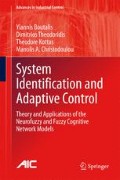Abstract
The indirect adaptive regulation of unknown nonlinear dynamical systems with multiple inputs and states (MIMS) using F-RHONNs under the presence of parameter and dynamic uncertainties, is considered in this chapter. The method is based on the new NF dynamical systems definition introduced in Chap. 2, which uses the concept of adaptive fuzzy systems (AFS) operating in conjunction with recurrent high order neural networks. Since the plant is considered unknown, we first propose the calculation of fuzzy output centers by systems data or linguistic information and in the sequel the fuzzy rules are approximated by appropriate HONNs. Thus, the identification scheme leads up to fuzzy subsystems approximated by recurrent high order neural networks, which however takes into account the centers of the fuzzy output partitions (F-RHONNs). Every high order neural network approximates a group of fuzzy rules associated with each center. The indirect regulation is achieved by first identifying the system around the current operation point, and then using its parameters to device the control law. Weight updating laws for the involved HONNs are provided, which guarantee that, under the presence of both parameter and dynamic uncertainties, both the identification error and the system states reach zero, or at least uniform ultimate boundedness of all signals in the closed-loop. The control signal is constructed to be valid for both square and nonsquare systems by using a pseudo-inversion. The existence of the control signal is always assured by employing the method of parameter hopping instead of the conventional projection method.
Access this chapter
Tax calculation will be finalised at checkout
Purchases are for personal use only
References
Boutalis, Y., Christodoulou, M., & Theodoridis, D. (2008). A new neuro-fuzzy intelligent method for indirect adaptive control of nonlinear systems via a novel approach of parameter hopping. In, Proceedings of Joint International Conferences in Soft Computing Intelligent Systems and Symposium on Advanced Intelligent Systems (pp. 918–923). Nagoya, Japan.
Boutalis, Y. S., Theodoridis, D. C., & Christodoulou, M. A. (2009). A new neuro fds definition for indirect adaptive control of unknown nonlinear systems using a method of parameter hopping. IEEE Transactions on Neural Networks, 20, 609–625.
Boutalis, Y. S., Christodoulou, M.A. & Theodoridis, D. C. (2013). Indirect adaptive control of nonlinear systems based on bilinear neurofuzzy approximation. International Journal of Neural Systems, 23, 17
Cortes, J. (2008). Discontinuous dynamical systems: A tutorial on solutions, nonsmooth analysis, and stability. IEEE Control Systems Magazine, 28, 36–73.
Filippov, A. (1998). Differential equations with discontinuous righthand sides. Norwell: Kluwer.
Ioannou, P., & Fidan, B. (2006). Adaptive control tutorial. USA: SIAM, Advances in Design and Control Series.
Kokotovic, P. V., Khalil, H. K., & O’Reilly, J., (1986). Singular perturbation methods in control: Analysis and design. New York: Academic Press.
Kosmatopoulos, E. B., & Ioannou, P. A. (1999). A switching adaptive controller for feedback linearizable systems. IEEE Transactions on Automatic Control, 44, 742–750.
Kosmatopoulos, E. B., & Ioannou, P. A. (2002). Robust switching adaptive control of multi-input nonlinear systems. IEEE Transactions on Automatic Control, 47, 610–624.
Leonhard, W. (1985). Control of electrical drives. Berlin: Springer.
Mandic, D. P. (2004). A generalized normalized gradient descent algorithm. IEEE Signal Processing Letters, 11, 115–118.
Margaris, N., Goutas, T., Doulgeri, Z., & Paschali, A. (1991). Loss minimization in dc drives. IEEE Transactions on Industrial Electronics, 38, 328–336.
Morse, A., Mayne, D., & Goodwin, G. (1992). Applications of hysteresis switching in parameter adaptive control. IEEE Transactions on Automatic Control, 34, 1343–1354.
Polycarpou, M., & Ioannou, P. (1993). On the existence and uniquness of solutions in adaptive control systems. IEEE Transactions on Automatic Control, 38, 474–479.
Popov, V. M. (1973). Hyperstability of Control Systems. NY: Springer.
Rovithakis, G. & M. A.Christodoulou. (2000). Adaptive control with recurrent high order neural networks (theory and industrial applications). In Advances in Industrial Control. London: Springer Verlag London Limited.
Theodoridis, D., Boutalis, Y. & Christodoulou, M. (2009a). A new neuro-fuzzy dynamical system definition based on high order neural network function approximators. In, European control conference ECC-09, Budapest, Hungary.
Theodoridis, D., Boutalis, Y., & Christodoulou, M. (2010). Indirect adaptive control of unknown multi variable nonlinear systems with parametric and dynamic uncertainties using a new neuro-fuzzy system description. International Journal of Neural Systems, 20, 129–148.
Theodoridis, D. C., Christodoulou, M. A., & Boutalis, Y. S. (2008). Indirect adaptive neuro—fuzzy control based on high order neural network function approximators. Proccedings of the 16th mediterranean conference on control and automation—MED08 (pp. 386–393). Corsica, France: Ajaccio.
Theodoridis, D. C., Boutalis, Y. S. & Christodoulou, M. A. (2009b). Direct adaptive control of unknown nonlinear systems using a new neuro-fuzzy method together with a novel approach of parameter hopping. Kybernetica, 45, 349–386.
Vamvoudakis, K. G. & Lewis, F. L. (2009). Online actor critic algorithm to solve the continuous-time infinite horizon optimal control problem. In Proc. Int. Joint Conf. on Neural Networks, 3180–3187, Atlanta.
Weller, S., & Goodwin, G. (1994). Hysteresis switching adaptive control of linear multivariable systems. IEEE Transactions on Automatic Control, 39, 1360–1375.
Yesildirek, A., & Lewis, F. L. (1995). Feedback linearization using neural networks. Automatica, 31, 1659–1664.
Author information
Authors and Affiliations
Corresponding author
Rights and permissions
Copyright information
© 2014 Springer International Publishing Switzerland
About this chapter
Cite this chapter
Boutalis, Y., Theodoridis, D., Kottas, T., Christodoulou, M.A. (2014). Indirect Adaptive Control Based on the Recurrent Neurofuzzy Model. In: System Identification and Adaptive Control. Advances in Industrial Control. Springer, Cham. https://doi.org/10.1007/978-3-319-06364-5_3
Download citation
DOI: https://doi.org/10.1007/978-3-319-06364-5_3
Published:
Publisher Name: Springer, Cham
Print ISBN: 978-3-319-06363-8
Online ISBN: 978-3-319-06364-5
eBook Packages: EngineeringEngineering (R0)

